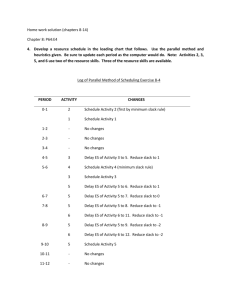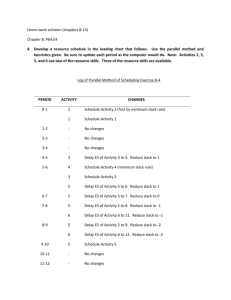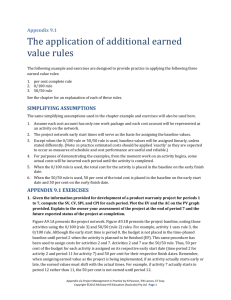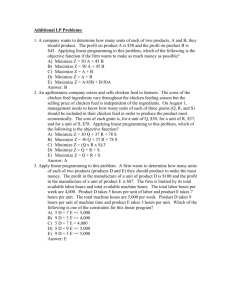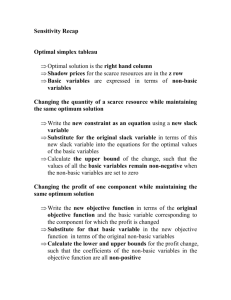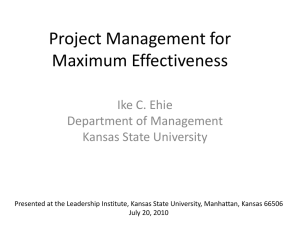HW Solution C8
advertisement
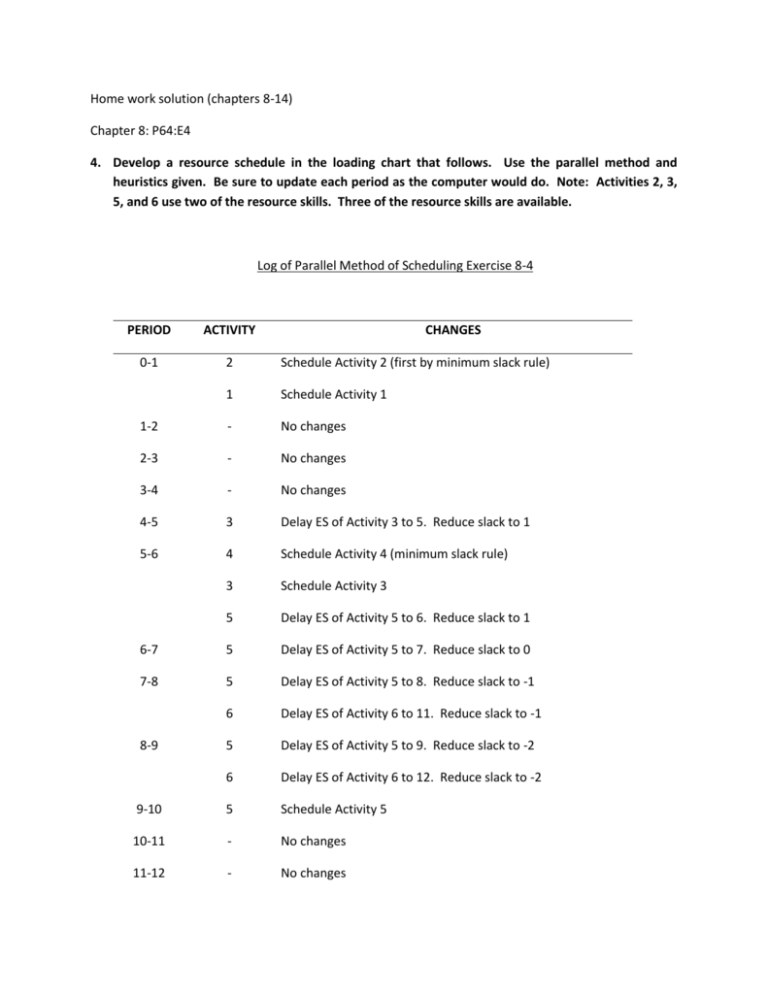
Home work solution (chapters 8-14) Chapter 8: P64:E4 4. Develop a resource schedule in the loading chart that follows. Use the parallel method and heuristics given. Be sure to update each period as the computer would do. Note: Activities 2, 3, 5, and 6 use two of the resource skills. Three of the resource skills are available. Log of Parallel Method of Scheduling Exercise 8-4 PERIOD ACTIVITY 0-1 2 Schedule Activity 2 (first by minimum slack rule) 1 Schedule Activity 1 1-2 - No changes 2-3 - No changes 3-4 - No changes 4-5 3 Delay ES of Activity 3 to 5. Reduce slack to 1 5-6 4 Schedule Activity 4 (minimum slack rule) 3 Schedule Activity 3 5 Delay ES of Activity 5 to 6. Reduce slack to 1 6-7 5 Delay ES of Activity 5 to 7. Reduce slack to 0 7-8 5 Delay ES of Activity 5 to 8. Reduce slack to -1 6 Delay ES of Activity 6 to 11. Reduce slack to -1 5 Delay ES of Activity 5 to 9. Reduce slack to -2 6 Delay ES of Activity 6 to 12. Reduce slack to -2 9-10 5 Schedule Activity 5 10-11 - No changes 11-12 - No changes 8-9 CHANGES 12-13 6 Schedule Activity 6 Chapter 9: P302:E4 4. If the indirect costs for each duration are $1,200 for 16 weeks, $1,130 for 15 weeks, $1,000 for 14 weeks, $900 for 13 weeks, $860 for 12 weeks, $820 for 11 weeks and $790 for 10 weeks, compute the total costs for each duration. Plot these costs on a graph. What is the optimum cost-time schedule? Note: The duration for this schedule is weeks and students should be told only to crash the network one week at a time (not days). For duration 14, B is chosen over D & E because it is the earliest task. If problems occur, you can crash D or E. Chapter 12: Page 408: Review Questions 3, 5, and 6. 3. What does the term “escalate” refer to, and why is it essential to project success? Escalation is a control mechanism for dealing with and resolving problems. The basic principle is that problems should be resolved at the lowest appropriate level within a set time limit (for example, 24 hours) or they are “escalated” to the next level of management. This process is repeated until the problem is resolved. Escalation discourages participants from forcing concessions by delaying decisions. It empowers people to solve problems. There is no shame in pushing significant problems up the hierarchy; at the same time management discourages subordinates from passing up problems that the subordinates should have resolved. Time is money on the project, and escalation contributes to quick and effective problem solving. 5. What does the acronym BATNA refer to, and why is it important to being a successful negotiator? BATNA stands for “best alternative to a negotiated agreement.” Essentially it represents the best alternative if you are unable to reach an agreement with the party you are negotiating with. BATNA reflects how dependent you are on the other party. If you have a strong BATNA you can walk away from a deal and say “no, unless we work towards a win/win scenario.” If you have a weak BATNA, then you are more likely to have to concede to the demands of the other party. BATNA is a true benchmark for determining whether you should accept an agreement. 6. How can a project manager influence customer expectations and perceptions? According to the met expectations model, customer satisfaction is a function of the extent to which perceived performance exceeds expectations. Through their interactions with customers, project managers can influence customers’ base expectations (what they expect to get) and perceptions of performance (what they actually received). The project manager, through frequent communication, educates clients so that they can make valid judgments as to project performance and reduces misunderstandings that can lead to disappointment and dissatisfaction. Chapter 13: Page 449, Exercise 5 5. The following labor hours data have been collected for a nanotechnology project for periods 1 through 6. Compute the SV, CV, SPI, and CPI for each period. Plot the EV and the AC on the summary graph provided (or a similar one). Plot the SPI, CPI and PCIB on the index graph provided (or a similar one). What is your assessment of the project at the end of period 6? After 6 time periods the project is roughly 66% complete and so far work on the project has taken 1,600 hours less work than planned. There is 400 hours worth of work on Activity 4 which was suppose to have been done that has not done. Since Activity 4 is on the critical path, the project is behind schedule. If schedule is the number priority, the project manager may want to consider investing some of the savings on accelerating critical activities. Status Report: Ending Period 1 Task 1 % Complete EV AC PV CV 50% 1000 500 1000 +500 0 1000 500 1000 +500 0 % Complete EV AC PV CV Finished 2000 1500 2000 +500 0 2000 1500 2000 +500 0 Cumulative Totals SV Status Report: Ending Period 2 Task 1 Cumulative Totals Status Report: Ending Period 3 SV Task % Complete EV AC PV CV 1 Finished 2000 1500 2000 +500 0 2 0% 0 0 1600 0 -1600 3 10% 300 200 500 +100 -200 4 20% 500 500 1000 0 -500 2800 2200 5100 +600 -2300 % Complete EV AC PV CV SV 1 Finished 2000 1500 2000 +500 0 2 50% 1200 1000 2400 +200 -1200 3 30% 900 800 1000 +100 -100 4 40% 1000 1500 2000 -500 -1000 5100 4800 7400 +300 -2300 % Complete EV AC PV CV SV 1 Finished 2000 1500 2000 +500 0 2 Finished 2400 2000 2400 +400 0 3 50% 1500 800 2000 +700 -500 4 60% 1500 1500 2200 0 -700 5 25% 400 400 400 0 0 7800 6200 9000 +1600 -1200 Cumulative Totals SV Status Report: Ending Period 4 Task Cumulative Totals Status Report: Ending Period 5 Task Cumulative Totals Status Report: Ending Period 6 Task % Complete EV AC PV CV 1 Finished 2000 1500 2000 +500 0 2 Finished 2400 2000 2400 +400 0 3 80% 2400 2100 2300 +300 +100 4 80% 2000 1800 2400 +200 -400 5 50% 800 600 800 +200 0 9600 8000 9900 +1600 -300 Cumulative Totals Indexes Period SPI CPI PCIB 1 1.00 2.00 .07 2 1.00 1.33 .14 SPI = EV / PV 3 .55 1.27 .19 CPI = EV / AC 4 .69 1.06 .35 PCIB = EV / BAC 5 .87 1.26 .54 6 .96 1.20 .66 SV
